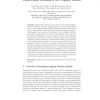Free Online Productivity Tools
i2Speak
i2Symbol
i2OCR
iTex2Img
iWeb2Print
iWeb2Shot
i2Type
iPdf2Split
iPdf2Merge
i2Bopomofo
i2Arabic
i2Style
i2Image
i2PDF
iLatex2Rtf
Sci2ools
ISBMS
2010
Springer
2010
Springer
Physics-Based Modeling of the Pregnant Woman
High quality obstetric images have become readily available with fast magnetic resonance imaging protocols or new 3D ultrasound probes. These obstetric images provide detailed information which can be used to create realistic models of the fetus at different stages of gestation. Unfortunately, the anatomy of the mother is only partially visible in the obstetric images and a full model of the pregnant woman can only be based on deformations of a non-pregnant woman body. Numerical pregnant women models are useful for a variety of applications, including dosimetry studies to assess the potential health effects of low-frequency electro-magnetic fields generated by power lines and electrical devices, planning of delivery procedure or training of obstetrical echographers. Only few models of pregnant women have been developed up to now, and they all lack realism and medical accuracy in representing the different stages of gestation and the anatomical variability of the fetal anatomy and p...
| Added | 18 May 2010 |
| Updated | 18 May 2010 |
| Type | Conference |
| Year | 2010 |
| Where | ISBMS |
| Authors | Juan Pablo de la Plata Alcalde, Lazar Bibin, Jérémie Anquez, Tamy Boubekeur, Elsa D. Angelini, Isabelle Bloch |
Comments (0)

